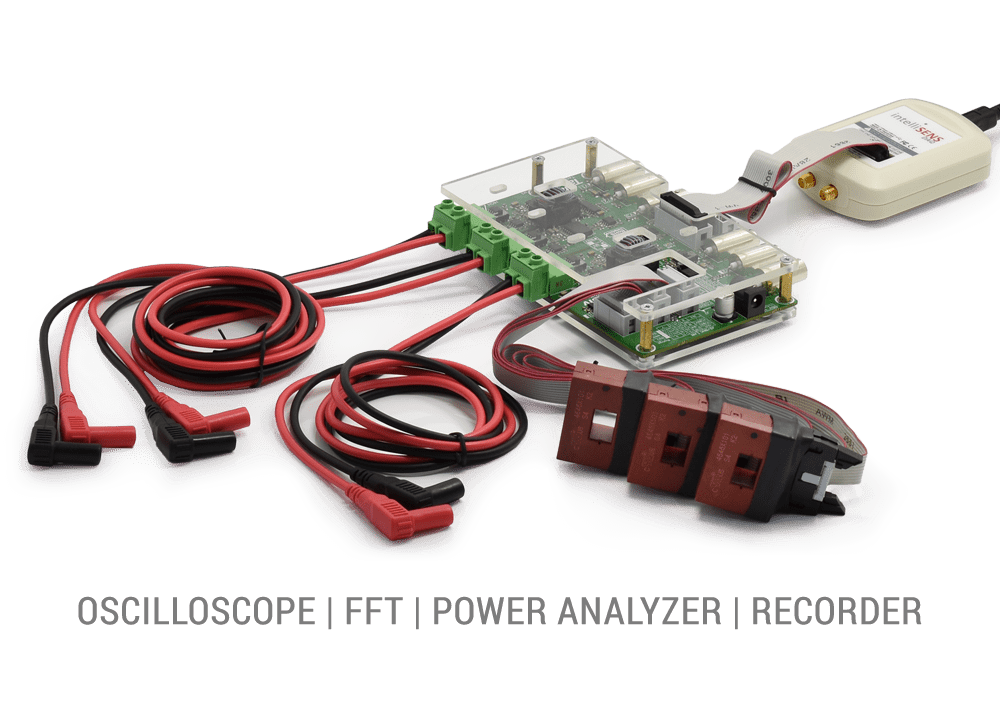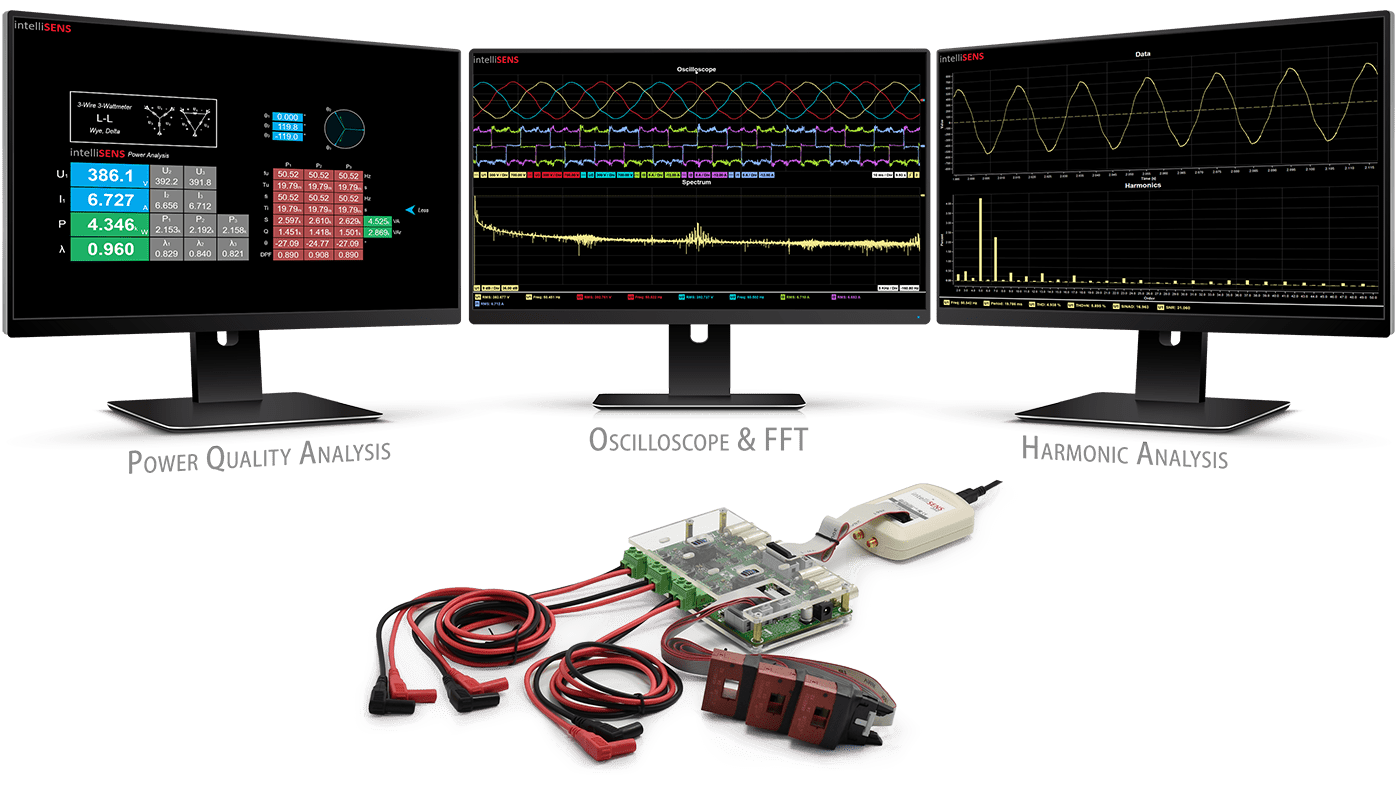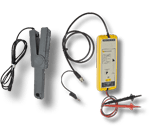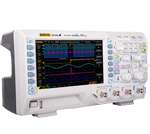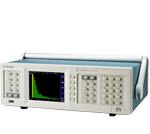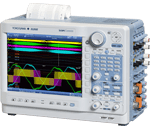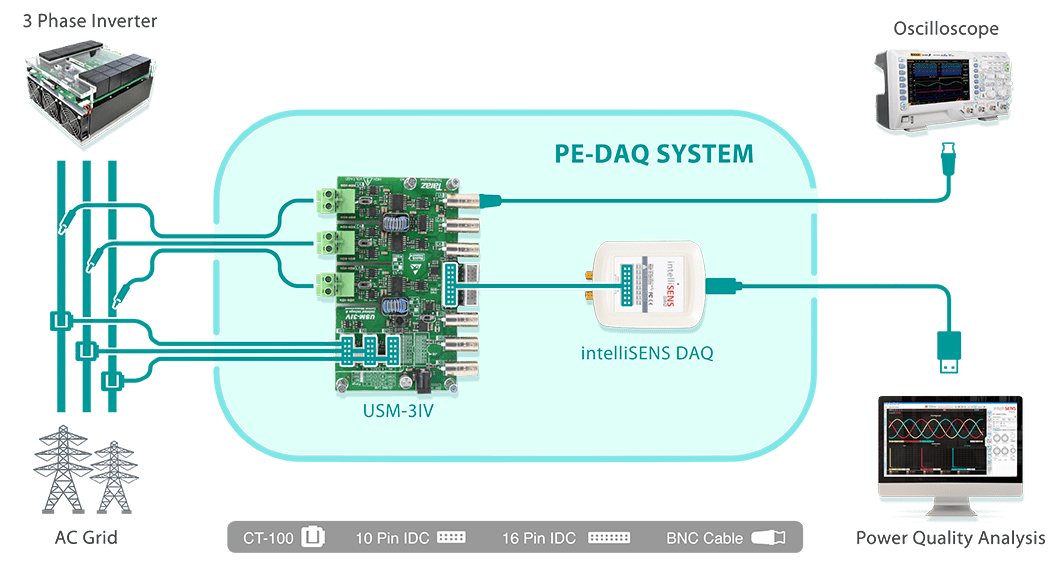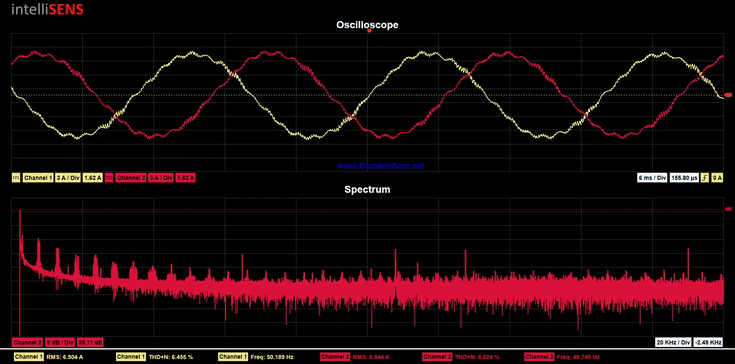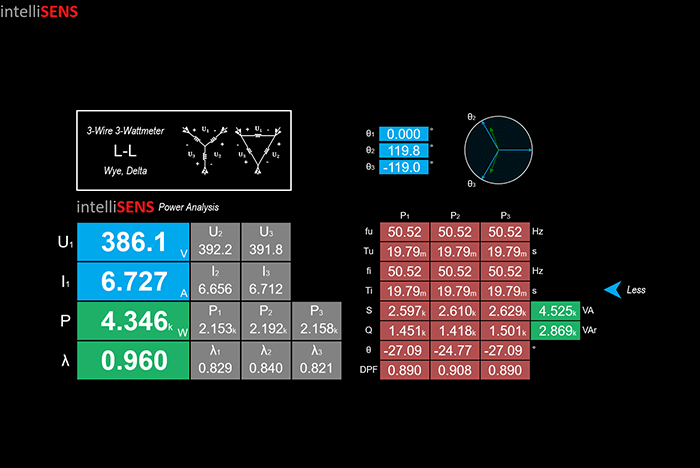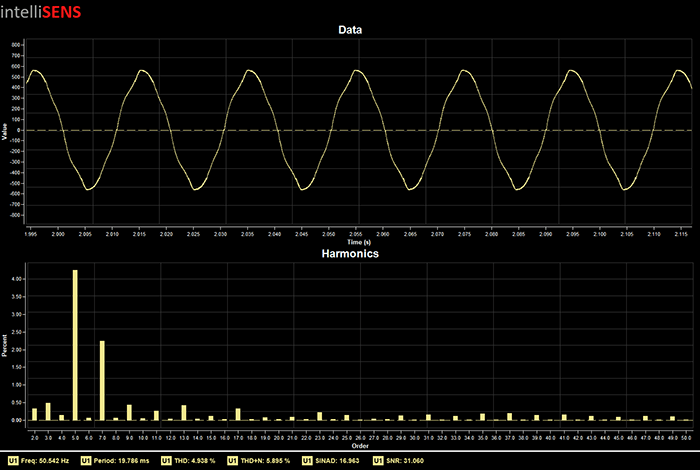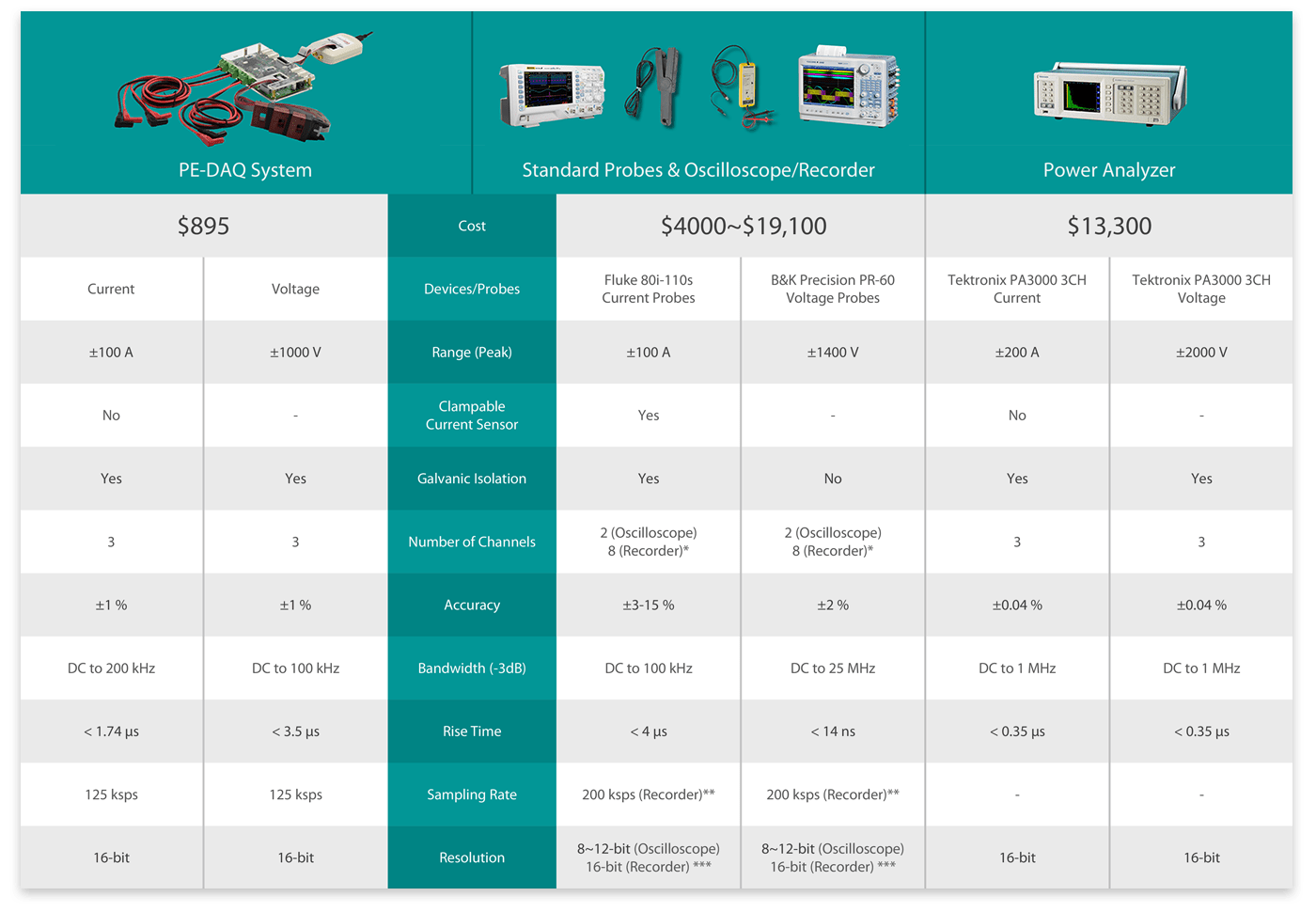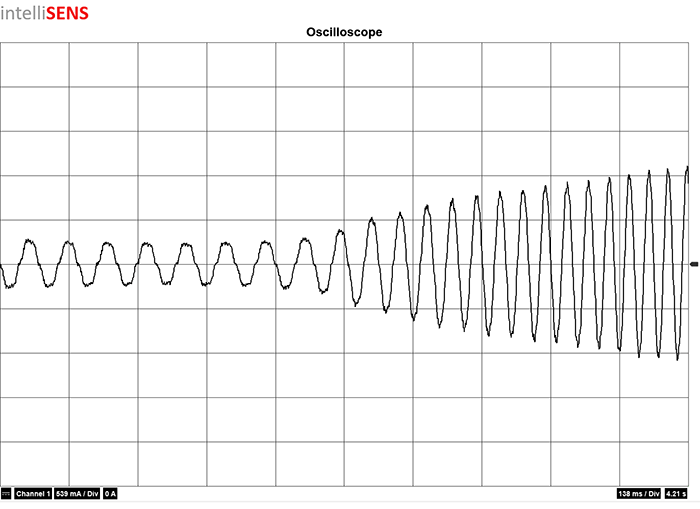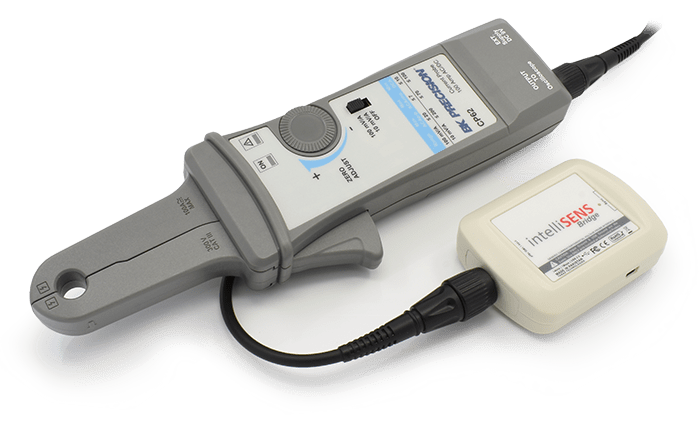Power Electronics Measurement & DAQ System
PE-DAQ
Applications
✓ 3 Phase Power Quality & Harmonics Analysis
✓ Power Electronics Hardware Monitoring
✓ Fault Conditions Behavior Analysis
✓ Transient Response Analysis
✓ Control System Stability Monitoring
Features
✓ 3 Voltage & 3 Current Channels with Galvanic Isolation
✓ Software Based Oscilloscope, Power Analyzer & Recorder
✓ Up to ±1000V & ±100A Measurement Range
✓ 100kHz Voltage & 200kHz Current Analog Bandwidth
✓ Simultaneous Sampling at 125 ksps, 16-bit Resolution
✓ BNC Outputs to Oscilloscope, dSPACE & Opal-RT
✓ Selectable 3V/5V Output for FPGA & DSP
The Complete Power Electronics Measurement System
PE-DAQ is a power electronics measurement & data acquisition system consisting of a galvanically isolated voltage and current sensor module (USM-3IV) with 3 channels each for voltage and current measurements and a USB DAQ (intelliSENS DAQ) to acquire measured data for analysis on a PC using the intelliSENS application software. Features like galvanic isolation, high noise immunity and universal connectivity provide safety, accuracy and flexibility, whereas, software enabled features like 16-bit emulated oscilloscope, 3 phase power quality analysis, harmonic analysis, data-logging and sharing make it an all in one measurement solution for any power electronics lab.
Low Cost Alternative to:
Voltage and Current Probes
PE-DAQ system enables isolated measurement of 3 voltage and 3 current channels with simultaneous connectivity to external oscilloscopes, replacing 6 conventional voltage and current probes.
Oscilloscope
The PE-DAQ intelliSENS software includes oscilloscope with wide array of measurements, math functions and FFT, achieving greater accuracy with 16-bit resolution compared to oscilloscopes.
Power Analyzer
Power Analyzer functionalities are supported by intelliSENS software including Power Factor (PF), Total Harmonic Distortion (THD) and other power measurements for single and three phase systems.
Recorder
Recorder functionality can be achieved using intelliSENS software. In addition, the recorded files retain complete analysis capabilities to enable further analysis by colleagues and collaborators.
Simultaneous Connectivity to Oscilloscope and Controllers
As the USM-3IV is equipped with multiple unipolar and bipolar output connectors, the PE-DAQ system can simultaneously connect to controllers and equipment for feedback and monitoring like oscilloscope and real-time simulators, hence, keeping flexibility of use along with advance analysis features made possible by the application software. Following connection options are available:
Simultaneous Connection Options
| Equipment | Output | Connector |
|---|---|---|
| Oscilloscopes | Bipolar ±10V | BNC |
| Real-Time Simulators (dSPACE, Typhoon HIL, Opal-RT, etc.) | Bipolar ±10V | BNC |
| DSP Controllers, FPGAs, Microcontrollers | Unipolar 3V/5V | IDC (16-pin) |
| Laptop/PC (USB through intelliSENS DAQ) | Bipolar ±10V | IDC (16-pin) |
Oscilloscope and Fast Fourier Transform (FFT) Spectrum Analysis
IntelliSENS comes with full fledged oscilloscope functionalities, including a wide array of measurements. In addition, advance math equations can be added to the waveform to provide more versatility. Furthermore, adjustable trigger and fluid control makes the use of intelliSENS oscilloscope much more user-friendly than traditional oscilloscopes.
intelliSENS software can also perform FFT analysis of the input signals, a feature only available in high end oscilloscopes and spectrum analyzers. Thus, making it accessible to students and researchers working on low budget. Furthermore, a dynamic range of 96 dB, which is much more than the usual 48 dB in traditional Digital Storage oscilloscopes (DSOs) with FFT, provides a robust and accurate depiction of different harmonics in the frequency domain.
Advanced Power Quality and Harmonic Analysis
Power electronics designers must comply with standards for parameters, like Power Factor (PF) and Total Harmonic Distortion (THD), while designing power electronics converters and inverters. These measurements can only be performed by power analyzers, which are very expensive. intelliSENS software can perform all these measurements and displays them in a format similar to power analyzers, making power quality and harmonic analysis available for students and researchers alike.
Recording of Experimental Data While Retaining Complete Analysis Capabilities
The main advantage of intelliSENS software is the ability to record experimental data, and share those interactive recordings with peers and colleagues far away, thus, improving teamwork phenomenally. On top of that, there is no limit to how long the real-time data can be recorded and the application software is completely free of cost. Consequently, introducing a new way for measuring and sharing data between students and researchers in the field of power electronics.
The recorded data files retain complete analysis capabilities. In other words, when a saved file is viewed, any information from the real-time analysis can be extracted again and further analysis can be made on the very same data that may have not been performed before. Therefore, enabling collaborative work between team members across different countries and institutions.
Comparison
* Note 1: Recorder model assumed to be Yokogawa DL850E Scopecorder with 16 high speed 16-bit analog channels. Number of channels are equally divided between voltage and current measurements.
** Note 2: The Recorder in comparison can simultaneously record 16 Channels at 100 ksps and 8 Channels at 200 ksps.
*** Note 3: Oscilloscope resolution differ as per oscilloscope model and performance, accuracy of measurements is directly dependent on the resolution of oscilloscope used.
Applications and Limitations
While the specifications of the PE-DAQ system, are less compelling than some of the listed equipment in the comparison table, the price difference makes it incredibly cost efficient and accessible, as it allows most of the experiments to be performed in a power electronics lab as mentioned in the application table. However, due to its comparatively low frequency bandwidth, certain applications such as, checking PWM output from inverter or verifying rise and fall time of a semiconductor switch are not possible. For these measurements, high bandwidth probes along with high bandwidth oscilloscopes are required.
| Application | PE-DAQ | Standard Equipment |
|---|---|---|
| 3 Phase Motor Current Monitoring | ✔ | ✔ |
| Measure Conversion Efficiency | ✔ | ✔ |
| Power Quality & Harmonic Analysis | ✔ | ✔ |
| Check Rise/Fall Time of Power Supply | ✔ | ✔ |
| Output Transient Response | ✔ | ✔ |
| Check Output PWM from inverter | ✘ | ✔ |
| IGBT/SiC Switches Rise/Fall Time | ✘ | ✔ |
Application Examples
Analyze Fault Condition Behavior, Load Transient Response and Control System Stability
Power electronics researchers have to monitor and analyze events, such as, fault condition behavior, load transient response and control system stability. These events are hard to monitor with oscilloscopes, whereas, Recorders are inaccessible due to their high cost. The intelliSENS DAQ provides a low cost solution for researchers and R&D engineers to monitor, analyze and record these events for future reference.
Sync with Third-Party Differential Voltage and Current Probes through intelliSENS Bridge
intelliSENS Bridge interface’s 3rd party Differential Voltage & Current probes to intelliSENS software, which can be viewed alongside measurements obtained from intelliSENS DAQ, giving the user flexibility to use available probes and access powerful features of the intelliSENS software.
Specifications
| Parameter | Voltage | Current |
|---|---|---|
| Number of Channels | 3 | 3 |
| Range | ±100/±1000 V | ±100 A |
| Analog Bandwidth | DC-100 kHz | DC-200 kHz |
| Analog Accuracy | 1 % | 1 % |
| Analog Offset | 50 mV | 25 mV |
| Analog Rise Time | 3.5 μs | 1.75 μs |
| Sampling Rate | 125 ksps, Simultaneous Sampling | |
| Resolution | 16-bit | |
| Connectivity | USB 2.0 HS (Compatible with USB 1.1) | |
| Operating System | Windows 7, 8, 8.1, 10 | |
| Software Support | Free intelliSENS Software |
* Note 1: All ratings are given at 25°C ambient temperature unless otherwise specified.

